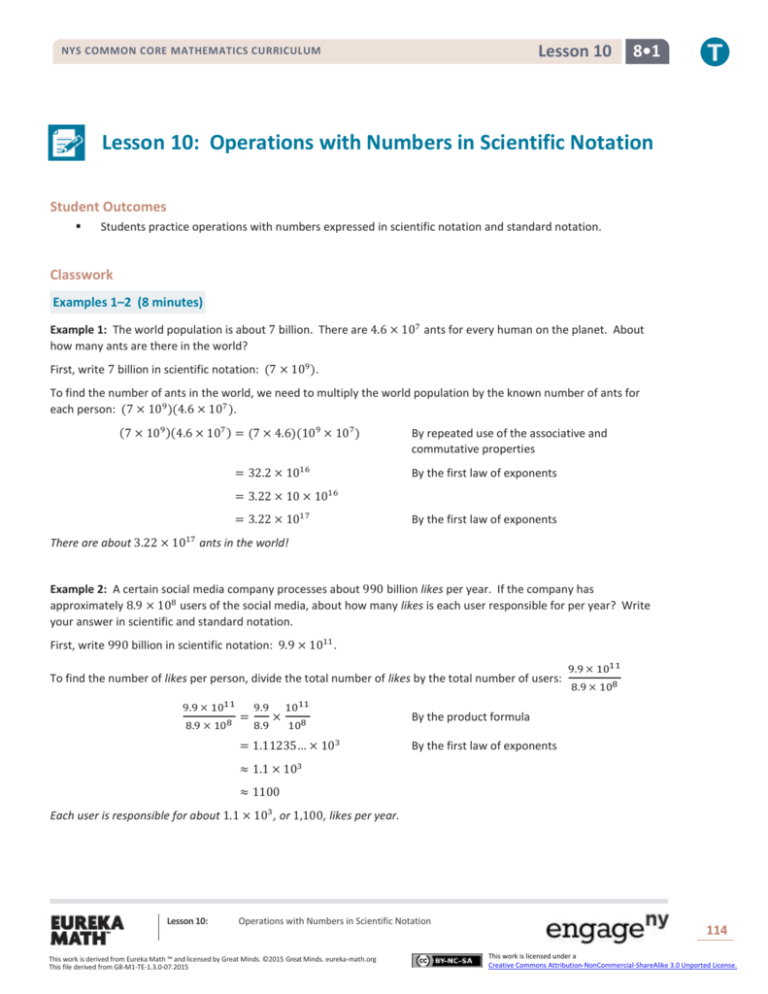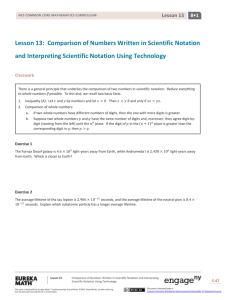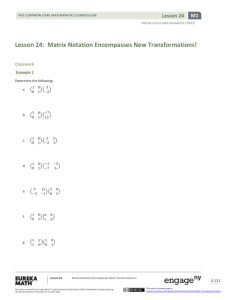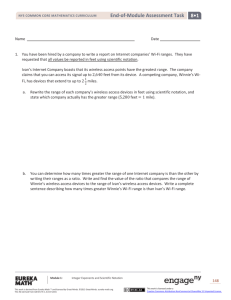Grade 8 Mathematics Module 1, Topic B, Lesson 10
advertisement

Lesson 10 NYS COMMON CORE MATHEMATICS CURRICULUM 8•1 Lesson 10: Operations with Numbers in Scientific Notation Student Outcomes Students practice operations with numbers expressed in scientific notation and standard notation. Classwork Examples 1–2 (8 minutes) Example 1: The world population is about 7 billion. There are 4.6 × 107 ants for every human on the planet. About how many ants are there in the world? First, write 7 billion in scientific notation: (7 × 109 ). To find the number of ants in the world, we need to multiply the world population by the known number of ants for each person: (7 × 109 )(4.6 × 107 ). (7 × 109 )(4.6 × 107 ) = (7 × 4.6)(109 × 107 ) = 32.2 × 1016 By repeated use of the associative and commutative properties By the first law of exponents 16 = 3.22 × 10 × 10 = 3.22 × 1017 By the first law of exponents There are about 3.22 × 1017 ants in the world! Example 2: A certain social media company processes about 990 billion likes per year. If the company has approximately 8.9 × 108 users of the social media, about how many likes is each user responsible for per year? Write your answer in scientific and standard notation. First, write 990 billion in scientific notation: 9.9 × 1011 . To find the number of likes per person, divide the total number of likes by the total number of users: 9.9 × 1011 8.9 × 108 = 9.9 8.9 × 1011 108 = 1.11235… × 103 9.9 × 1011 8.9 × 108 By the product formula By the first law of exponents ≈ 1.1 × 103 ≈ 1100 Each user is responsible for about 1.1 × 103 , or 1,100, likes per year. Lesson 10: Operations with Numbers in Scientific Notation This work is derived from Eureka Math ™ and licensed by Great Minds. ©2015 Great Minds. eureka-math.org This file derived from G8-M1-TE-1.3.0-07.2015 114 This work is licensed under a Creative Commons Attribution-NonCommercial-ShareAlike 3.0 Unported License. Lesson 10 NYS COMMON CORE MATHEMATICS CURRICULUM 8•1 Exercises 1– 2 (10 minutes) Have students complete Exercises 1 and 2 independently. Exercise 1 The speed of light is 𝟑𝟎𝟎, 𝟎𝟎𝟎, 𝟎𝟎𝟎 meters per second. The sun is approximately 𝟏. 𝟓 × 𝟏𝟎𝟏𝟏 meters from Earth. How many seconds does it take for sunlight to reach Earth? 𝟑𝟎𝟎 𝟎𝟎𝟎 𝟎𝟎𝟎 = 𝟑 × 𝟏𝟎𝟖 𝟏. 𝟓 × 𝟏𝟎𝟏𝟏 𝟏. 𝟓 𝟏𝟎𝟏𝟏 = × 𝟑 × 𝟏𝟎𝟖 𝟑 𝟏𝟎𝟖 = 𝟎. 𝟓 × 𝟏𝟎𝟑 = 𝟎. 𝟓 × 𝟏𝟎 × 𝟏𝟎𝟐 = 𝟓 × 𝟏𝟎𝟐 It takes 𝟓𝟎𝟎 seconds for sunlight to reach Earth. Exercise 2 The mass of the moon is about 𝟕. 𝟑 × 𝟏𝟎𝟐𝟐 𝐤𝐠. It would take approximately 𝟐𝟔, 𝟎𝟎𝟎, 𝟎𝟎𝟎 moons to equal the mass of the sun. Determine the mass of the sun. 𝟐𝟔 𝟎𝟎𝟎 𝟎𝟎𝟎 = 𝟐. 𝟔 × 𝟏𝟎𝟕 (𝟐. 𝟔 × 𝟏𝟎𝟕 )(𝟕. 𝟑 × 𝟏𝟎𝟐𝟐 ) = (𝟐. 𝟔 × 𝟕. 𝟑)(𝟏𝟎𝟕 × 𝟏𝟎𝟐𝟐 ) = 𝟏𝟖. 𝟗𝟖 × 𝟏𝟎𝟐𝟗 = 𝟏. 𝟖𝟗𝟖 × 𝟏𝟎 × 𝟏𝟎𝟐𝟗 = 𝟏. 𝟖𝟗𝟖 × 𝟏𝟎𝟑𝟎 The mass of the sun is 𝟏. 𝟖𝟗𝟖 × 𝟏𝟎𝟑𝟎 𝐤𝐠. Example 3 (8 minutes) In 2010, Americans generated 2.5 × 108 tons of garbage. There are about 2,000 landfills in the United States. Assuming that each landfill is the same size and that trash is divided equally among them, determine how many tons of garbage were sent to each landfill in 2010. First, write 2,000 in scientific notation: 2 × 103 . To find the number of tons of garbage sent to each landfill, divide the total weight of the garbage by the number of landfills: 2.5 × 108 2 × 103 . 2.5 × 108 2 × 103 = 2.5 2 × 108 103 = 1.25 × 105 By the product formula By the first law of exponents Each landfill received 1.25 × 105 tons of garbage in 2010. Actually, not all garbage went to landfills. Some of it was recycled and composted. The amount of recycled and composted material accounted for about 85 million tons of the 2.5 × 108 tons of garbage. Given this new information, how much garbage was actually sent to each landfill? Lesson 10: Operations with Numbers in Scientific Notation This work is derived from Eureka Math ™ and licensed by Great Minds. ©2015 Great Minds. eureka-math.org This file derived from G8-M1-TE-1.3.0-07.2015 115 This work is licensed under a Creative Commons Attribution-NonCommercial-ShareAlike 3.0 Unported License. Lesson 10 NYS COMMON CORE MATHEMATICS CURRICULUM 8•1 First, write 85 million in scientific notation: 8.5 × 107 . Next, subtract the amount of recycled and composted material from the garbage: 2.5 × 108 − 8.5 × 107 . To subtract, we must give each number the same order of magnitude and then use the distributive property. 2.5 × 108 − 8.5 × 107 = (2.5 × 10) × 107 − 8.5 × 107 By the first law of exponents = (2.5 × 10) − 8.5)) × 107 By the distributive property = (25 − 8.5) × 107 = 16.5 × 107 = 1.65 × 10 × 107 = 1.65 × 108 By the first law of exponents Now, divide the new amount of garbage by the number of landfills: 1.65 × 108 2 × 103 = 1.65 2 × 1.65 × 108 2 × 103 . 108 By the product formula 103 = 0.825 × 105 = 0.825 × 10 × 10 By the first law of exponents 4 By the first law of exponents = 8.25 × 104 Each landfill actually received 8.25 × 104 tons of garbage in 2010. Exercises 3–5 (10 minutes) Have students complete Exercises 3–5 independently. Exercise 3 The mass of Earth is 𝟓. 𝟗 × 𝟏𝟎𝟐𝟒 𝐤𝐠. The mass of Pluto is 𝟏𝟑, 𝟎𝟎𝟎, 𝟎𝟎𝟎, 𝟎𝟎𝟎, 𝟎𝟎𝟎, 𝟎𝟎𝟎, 𝟎𝟎𝟎, 𝟎𝟎𝟎 𝐤𝐠. Compared to Pluto, how much greater is Earth’s mass than Pluto’s mass? 𝟏𝟑 𝟎𝟎𝟎 𝟎𝟎𝟎 𝟎𝟎𝟎 𝟎𝟎𝟎 𝟎𝟎𝟎 𝟎𝟎𝟎 𝟎𝟎𝟎 = 𝟏. 𝟑 × 𝟏𝟎𝟐𝟐 𝟓. 𝟗 × 𝟏𝟎𝟐𝟒 − 𝟏. 𝟑 × 𝟏𝟎𝟐𝟐 = (𝟓. 𝟗 × 𝟏𝟎𝟐 ) × 𝟏𝟎𝟐𝟐 − 𝟏. 𝟑 × 𝟏𝟎𝟐𝟐 = (𝟓𝟗𝟎 − 𝟏. 𝟑) × 𝟏𝟎𝟐𝟐 = 𝟓𝟖𝟖. 𝟕 × 𝟏𝟎𝟐𝟐 = 𝟓. 𝟖𝟖𝟕 × 𝟏𝟎𝟐 × 𝟏𝟎𝟐𝟐 = 𝟓. 𝟖𝟖𝟕 × 𝟏𝟎𝟐𝟒 The mass of Earth is 𝟓. 𝟖𝟖𝟕 × 𝟏𝟎𝟐𝟒 𝐤𝐠 greater than the mass of Pluto. Lesson 10: Operations with Numbers in Scientific Notation This work is derived from Eureka Math ™ and licensed by Great Minds. ©2015 Great Minds. eureka-math.org This file derived from G8-M1-TE-1.3.0-07.2015 116 This work is licensed under a Creative Commons Attribution-NonCommercial-ShareAlike 3.0 Unported License. Lesson 10 NYS COMMON CORE MATHEMATICS CURRICULUM 8•1 Exercise 4 Using the information in Exercises 2 and 3, find the combined mass of the moon, Earth, and Pluto. 𝟕. 𝟑 × 𝟏𝟎𝟐𝟐 + 𝟏. 𝟑 × 𝟏𝟎𝟐𝟐 + 𝟓. 𝟗 × 𝟏𝟎𝟐𝟒 = (𝟕. 𝟑 × 𝟏𝟎𝟐𝟐 + 𝟏. 𝟑 × 𝟏𝟎𝟐𝟐 ) + 𝟓. 𝟗 × 𝟏𝟎𝟐𝟒 = 𝟖. 𝟔 × 𝟏𝟎𝟐𝟐 + 𝟓. 𝟗 × 𝟏𝟎𝟐𝟒 = (𝟖. 𝟔 + 𝟓𝟗𝟎) × 𝟏𝟎𝟐𝟐 = 𝟓𝟗𝟖. 𝟔 × 𝟏𝟎𝟐𝟐 = 𝟓. 𝟗𝟖𝟔 × 𝟏𝟎𝟐 × 𝟏𝟎𝟐𝟐 = 𝟓. 𝟗𝟖𝟔 × 𝟏𝟎𝟐𝟒 The combined mass of the moon, Earth, and Pluto is 𝟓. 𝟗𝟖𝟔 × 𝟏𝟎𝟐𝟒 𝐤𝐠. Exercise 5 How many combined moon, Earth, and Pluto masses (i.e., the answer to Exercise 4) are needed to equal the mass of the sun (i.e., the answer to Exercise 2)? 𝟏. 𝟖𝟗𝟖 × 𝟏𝟎𝟑𝟎 𝟏. 𝟖𝟗𝟖 𝟏𝟎𝟑𝟎 = × 𝟓. 𝟗𝟖𝟔 × 𝟏𝟎𝟐𝟒 𝟓. 𝟗𝟖𝟔 𝟏𝟎𝟐𝟒 = 𝟎. 𝟑𝟏𝟕𝟎… × 𝟏𝟎𝟔 ≈ 𝟎. 𝟑𝟐 × 𝟏𝟎𝟔 = 𝟎. 𝟑𝟐 × 𝟏𝟎 × 𝟏𝟎𝟓 = 𝟑. 𝟐 × 𝟏𝟎𝟓 It would take 𝟑. 𝟐 × 𝟏𝟎𝟓 combined masses of the moon, Earth, and Pluto to equal the mass of the sun. Closing (4 minutes) Summarize, or have students summarize, the lesson. We can perform all operations for numbers expressed in scientific notation or standard notation. Exit Ticket (5 minutes) Lesson 10: Operations with Numbers in Scientific Notation This work is derived from Eureka Math ™ and licensed by Great Minds. ©2015 Great Minds. eureka-math.org This file derived from G8-M1-TE-1.3.0-07.2015 117 This work is licensed under a Creative Commons Attribution-NonCommercial-ShareAlike 3.0 Unported License. Lesson 10 NYS COMMON CORE MATHEMATICS CURRICULUM Name 8•1 Date Lesson 10: Operations with Numbers in Scientific Notation Exit Ticket 1. The speed of light is 3 × 108 meters per second. The sun is approximately 230,000,000,000 meters from Mars. How many seconds does it take for sunlight to reach Mars? 2. If the sun is approximately 1.5 × 1011 meters from Earth, what is the approximate distance from Earth to Mars? Lesson 10: Operations with Numbers in Scientific Notation This work is derived from Eureka Math ™ and licensed by Great Minds. ©2015 Great Minds. eureka-math.org This file derived from G8-M1-TE-1.3.0-07.2015 118 This work is licensed under a Creative Commons Attribution-NonCommercial-ShareAlike 3.0 Unported License. Lesson 10 NYS COMMON CORE MATHEMATICS CURRICULUM 8•1 Exit Ticket Sample Solutions 1. The speed of light is 𝟑 × 𝟏𝟎𝟖 meters per second. The sun is approximately 𝟐𝟑𝟎, 𝟎𝟎𝟎, 𝟎𝟎𝟎, 𝟎𝟎𝟎 meters from Mars. How many seconds does it take for sunlight to reach Mars? 𝟐𝟑𝟎 𝟎𝟎𝟎 𝟎𝟎𝟎 𝟎𝟎𝟎 = 𝟐. 𝟑 × 𝟏𝟎𝟏𝟏 𝟐. 𝟑 × 𝟏𝟎𝟏𝟏 𝟐. 𝟑 𝟏𝟎𝟏𝟏 = × 𝟑 × 𝟏𝟎𝟖 𝟑 𝟏𝟎𝟖 = 𝟎. 𝟕𝟔𝟔𝟔… × 𝟏𝟎𝟑 ≈ 𝟎. 𝟕𝟕 × 𝟏𝟎 × 𝟏𝟎𝟐 ≈ 𝟕. 𝟕 × 𝟏𝟎𝟐 It takes approximately 𝟕𝟕𝟎 seconds for sunlight to reach Mars. 2. If the sun is approximately 𝟏. 𝟓 × 𝟏𝟎𝟏𝟏 meters from Earth, what is the approximate distance from Earth to Mars? (𝟐. 𝟑 × 𝟏𝟎𝟏𝟏 ) − (𝟏. 𝟓 × 𝟏𝟎𝟏𝟏 ) = (𝟐. 𝟑 − 𝟏. 𝟓) × 𝟏𝟎𝟏𝟏 = 𝟎. 𝟖 × 𝟏𝟎𝟏𝟏 = 𝟎. 𝟖 × 𝟏𝟎 × 𝟏𝟎𝟏𝟎 = 𝟖 × 𝟏𝟎𝟏𝟎 The distance from Earth to Mars is 𝟖 × 𝟏𝟎𝟏𝟎 meters. Problem Set Sample Solutions Have students practice operations with numbers written in scientific notation and standard notation. 1. The sun produces 𝟑. 𝟖 × 𝟏𝟎𝟐𝟕 joules of energy per second. How much energy is produced in a year? (Note: a year is approximately 𝟑𝟏, 𝟎𝟎𝟎, 𝟎𝟎𝟎 seconds). 𝟑𝟏 𝟎𝟎𝟎 𝟎𝟎𝟎 = 𝟑. 𝟏 × 𝟏𝟎𝟕 𝟐𝟕 )(𝟑. (𝟑. 𝟖 × 𝟏𝟎 𝟏 × 𝟏𝟎𝟕 ) = (𝟑. 𝟖 × 𝟑. 𝟏)(𝟏𝟎𝟐𝟕 × 𝟏𝟎𝟕 ) = 𝟏𝟏. 𝟕𝟖 × 𝟏𝟎𝟑𝟒 = 𝟏. 𝟏𝟕𝟖 × 𝟏𝟎 × 𝟏𝟎𝟑𝟒 = 𝟏. 𝟏𝟕𝟖 × 𝟏𝟎𝟑𝟓 The sun produces 𝟏. 𝟏𝟕𝟖 × 𝟏𝟎𝟑𝟓 joules of energy in a year. Lesson 10: Operations with Numbers in Scientific Notation This work is derived from Eureka Math ™ and licensed by Great Minds. ©2015 Great Minds. eureka-math.org This file derived from G8-M1-TE-1.3.0-07.2015 119 This work is licensed under a Creative Commons Attribution-NonCommercial-ShareAlike 3.0 Unported License. Lesson 10 NYS COMMON CORE MATHEMATICS CURRICULUM 2. 8•1 On average, Mercury is about 𝟓𝟕, 𝟎𝟎𝟎, 𝟎𝟎𝟎 𝐤𝐦 from the sun, whereas Neptune is about 𝟒. 𝟓 × 𝟏𝟎𝟗 𝐤𝐦 from the sun. What is the difference between Mercury’s and Neptune’s distances from the sun? 𝟓𝟕 𝟎𝟎𝟎 𝟎𝟎𝟎 = 𝟓. 𝟕 × 𝟏𝟎𝟕 𝟗 𝟒. 𝟓 × 𝟏𝟎 − 𝟓. 𝟕 × 𝟏𝟎𝟕 = (𝟒. 𝟓 × 𝟏𝟎𝟐 ) × 𝟏𝟎𝟕 − 𝟓. 𝟕 × 𝟏𝟎𝟕 = 𝟒𝟓𝟎 × 𝟏𝟎𝟕 − 𝟓. 𝟕 × 𝟏𝟎𝟕 = (𝟒𝟓𝟎 − 𝟓. 𝟕) × 𝟏𝟎𝟕 = 𝟒𝟒𝟒. 𝟑 × 𝟏𝟎𝟕 = 𝟒. 𝟒𝟒𝟑 × 𝟏𝟎𝟐 × 𝟏𝟎𝟕 = 𝟒. 𝟒𝟒𝟑 × 𝟏𝟎𝟗 The difference in the distance of Mercury and Neptune from the sun is 𝟒. 𝟒𝟒𝟑 × 𝟏𝟎𝟗 𝐤𝐦. 3. The mass of Earth is approximately 𝟓. 𝟗 × 𝟏𝟎𝟐𝟒 𝐤𝐠, and the mass of Venus is approximately 𝟒. 𝟗 × 𝟏𝟎𝟐𝟒 𝐤𝐠. a. Find their combined mass. 𝟓. 𝟗 × 𝟏𝟎𝟐𝟒 + 𝟒. 𝟗 × 𝟏𝟎𝟐𝟒 = (𝟓. 𝟗 + 𝟒. 𝟗) × 𝟏𝟎𝟐𝟒 = 𝟏𝟎. 𝟖 × 𝟏𝟎𝟐𝟒 = 𝟏. 𝟎𝟖 × 𝟏𝟎 × 𝟏𝟎𝟐𝟒 = 𝟏. 𝟎𝟖 × 𝟏𝟎𝟐𝟓 The combined mass of Earth and Venus is 𝟏. 𝟎𝟖 × 𝟏𝟎𝟐𝟓 𝐤𝐠. b. Given that the mass of the sun is approximately 𝟏. 𝟗 × 𝟏𝟎𝟑𝟎 𝐤𝐠, how many Venuses and Earths would it take to equal the mass of the sun? 𝟏. 𝟗 × 𝟏𝟎𝟑𝟎 𝟏. 𝟗 𝟏𝟎𝟑𝟎 = × 𝟏. 𝟎𝟖 × 𝟏𝟎𝟐𝟓 𝟏. 𝟎𝟖 𝟏𝟎𝟐𝟓 = 𝟏. 𝟕𝟓𝟗𝟐𝟓… × 𝟏𝟎𝟓 ≈ 𝟏. 𝟖 × 𝟏𝟎𝟓 It would take approximately 𝟏. 𝟖 × 𝟏𝟎𝟓 Venuses and Earths to equal the mass of the sun. Lesson 10: Operations with Numbers in Scientific Notation This work is derived from Eureka Math ™ and licensed by Great Minds. ©2015 Great Minds. eureka-math.org This file derived from G8-M1-TE-1.3.0-07.2015 120 This work is licensed under a Creative Commons Attribution-NonCommercial-ShareAlike 3.0 Unported License.










